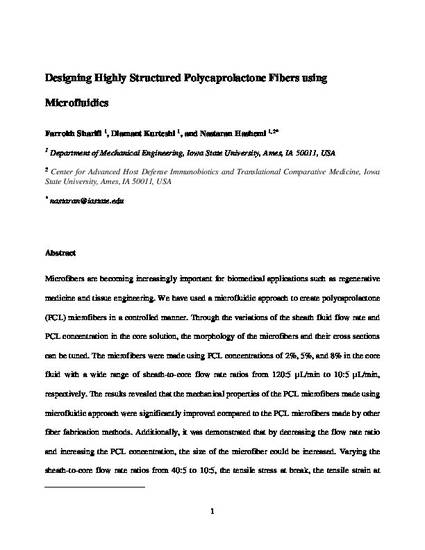
Microfibers are becoming increasingly important for biomedical applications such as regenerative medicine and tissue engineering. We have used a microfluidic approach to create polycaprolactone (PCL) microfibers in a controlled manner. Through the variations of the sheath fluid flow rate and PCL concentration in the core solution, the morphology of the microfibers and their cross-sections can be tuned. The microfibers were made using PCL concentrations of 2%, 5%, and 8% in the core fluid with a wide range of sheath-to-core flow rate ratios from 120:5 µL/min to 10:5 µL/min, respectively. The results revealed that the mechanical properties of the PCL microfibers made using microfluidic approach were significantly improved compared to the PCL microfibers made by other fiber fabrication methods. Additionally, it was demonstrated that by decreasing the flow rate ratio and increasing the PCL concentration, the size of the microfiber could be increased. Varying the sheath-to-core flow rate ratios from 40:5 to 10:5, the tensile stress at break, the tensile strain at break, and the Young׳s modulus were enhanced from 24.51 MPa to 77.07 MPa, 567% to 1420%, and 247.25 MPa to 539.70 MPa, respectively. The porosity and roughness of microfiber decreased when the PCL concentration increased from 2% to 8%, whereas changing the flow rate ratio did not have considerable impact on the microfiber roughness.
Available at: http://works.bepress.com/nastaran_hashemi/43/

This is a manuscript of an article published as Sharifi, Farrokh, Diamant Kurteshi, and Nastaran Hashemi. "Designing highly structured polycaprolactone fibers using microfluidics." Journal of the Mechanical Behavior of Biomedical Materials 61 (2016): 530-540. DOI: 10.1016/j.jmbbm.2016.04.005. Posted with permission.